Tools
of The Trade
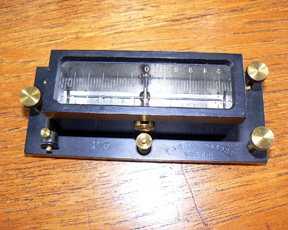 Dip needle, engraved "E S Ritchie &
Sons". Case label marked US navy Bureau of Ships. Made by C G
Conn Ltd, Elkhart, Indiana.
Dip needle, engraved "E S Ritchie &
Sons". Case label marked US navy Bureau of Ships. Made by C G
Conn Ltd, Elkhart, Indiana.
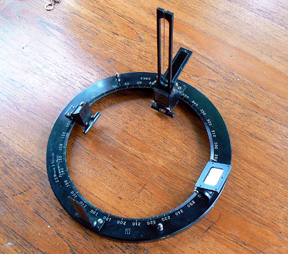 Azimuth circle, marked E S Ritchie &
Sons, Pembroke, Mass.
Azimuth circle, marked E S Ritchie &
Sons, Pembroke, Mass.
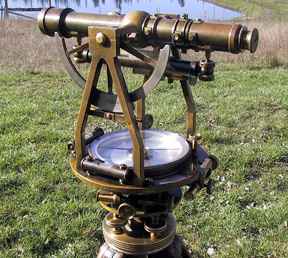 Engineer's transit signed W&LE
Gurley No. 9556. I use this for finding local magnetic variation
ashore, and for finding the true bearing of city streets. The sun
or a star is used to align the transit circle to true North and South.
Engineer's transit signed W&LE
Gurley No. 9556. I use this for finding local magnetic variation
ashore, and for finding the true bearing of city streets. The sun
or a star is used to align the transit circle to true North and South.
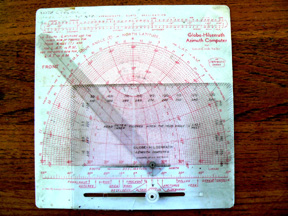 Globe
Hilsenrath azimuth computer. Not a computer in the modern sense,
more like a slide rule. It solves for azimuth, using declination,
latitude, and local hour angle or local apparent time. The only
slide rule type device which solves for time azimuth, as far as I know.
There are slide rules which solve for altitude azimuth, but those
are not convenient for compass adjusting.
Globe
Hilsenrath azimuth computer. Not a computer in the modern sense,
more like a slide rule. It solves for azimuth, using declination,
latitude, and local hour angle or local apparent time. The only
slide rule type device which solves for time azimuth, as far as I know.
There are slide rules which solve for altitude azimuth, but those
are not convenient for compass adjusting.
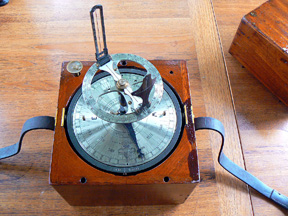 London Polaris, a specialized type of pelorus
which solves for azimuth mechanically. It's an equinoctial
sundial, adjustable for latitude. The latitude scale is under the
upper dial, which tilts accordingly. This dial is marked with the
hours of the day, and 360 degrees, each degree with a value of four
minutes of time. The sight vanes are set to the local apparent
time, and the whole is rotated to line up the sun's shadow. When
adjusted for time and latitude, the upper dial is on a parallel
plane with the earth's equator, and the pointer points to geographical
North. The pointer can be adjusted to the local variation, so
that the dial indicates the magnetic heading based on the sun's azimuth
but without having to solve for azimuth.
London Polaris, a specialized type of pelorus
which solves for azimuth mechanically. It's an equinoctial
sundial, adjustable for latitude. The latitude scale is under the
upper dial, which tilts accordingly. This dial is marked with the
hours of the day, and 360 degrees, each degree with a value of four
minutes of time. The sight vanes are set to the local apparent
time, and the whole is rotated to line up the sun's shadow. When
adjusted for time and latitude, the upper dial is on a parallel
plane with the earth's equator, and the pointer points to geographical
North. The pointer can be adjusted to the local variation, so
that the dial indicates the magnetic heading based on the sun's azimuth
but without having to solve for azimuth.
 another
view of the London Polaris
another
view of the London Polaris
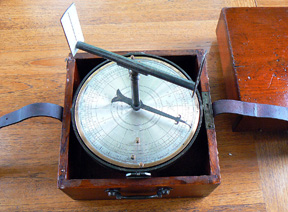 Field's
pelorus, signed J M Fields, San Francisco. Used with shore bearings or
the sun with the sight vanes as a shadow vane and also has a shadow
pin.
Field's
pelorus, signed J M Fields, San Francisco. Used with shore bearings or
the sun with the sight vanes as a shadow vane and also has a shadow
pin.
 Pocket magnetometer, very convenient for
adjusting the heeling magnet
Pocket magnetometer, very convenient for
adjusting the heeling magnet
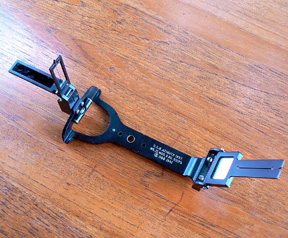 US navy azimuth instrument, Mark II model 3,
dated 1942, which is probably the date of the contract let to National
Electrical Machine Shops, the maker. I bored a hole in the frame
to fit the center pin of C.Plath and Cassens & Plath compasses. It
works much the same as the standard navy azimuth circle, with
reflecting mirror and prism.
US navy azimuth instrument, Mark II model 3,
dated 1942, which is probably the date of the contract let to National
Electrical Machine Shops, the maker. I bored a hole in the frame
to fit the center pin of C.Plath and Cassens & Plath compasses. It
works much the same as the standard navy azimuth circle, with
reflecting mirror and prism.
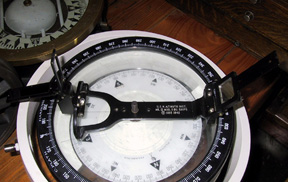 The
navy azimuth instrument fitted onto a C Plath compass
The
navy azimuth instrument fitted onto a C Plath compass
 testing rig for azimuth circles, for testing
the adjustment of mirror and prisms. Nicely made, I suspect that
it was made by Northwest Instrument Co., Seattle
testing rig for azimuth circles, for testing
the adjustment of mirror and prisms. Nicely made, I suspect that
it was made by Northwest Instrument Co., Seattle
 Dip needle, engraved "E S Ritchie &
Sons". Case label marked US navy Bureau of Ships. Made by C G
Conn Ltd, Elkhart, Indiana.
Dip needle, engraved "E S Ritchie &
Sons". Case label marked US navy Bureau of Ships. Made by C G
Conn Ltd, Elkhart, Indiana.  Azimuth circle, marked E S Ritchie &
Sons, Pembroke, Mass.
Azimuth circle, marked E S Ritchie &
Sons, Pembroke, Mass.  Engineer's transit signed W&LE
Gurley No. 9556. I use this for finding local magnetic variation
ashore, and for finding the true bearing of city streets. The sun
or a star is used to align the transit circle to true North and South.
Engineer's transit signed W&LE
Gurley No. 9556. I use this for finding local magnetic variation
ashore, and for finding the true bearing of city streets. The sun
or a star is used to align the transit circle to true North and South.  Globe
Hilsenrath azimuth computer. Not a computer in the modern sense,
more like a slide rule. It solves for azimuth, using declination,
latitude, and local hour angle or local apparent time. The only
slide rule type device which solves for time azimuth, as far as I know.
There are slide rules which solve for altitude azimuth, but those
are not convenient for compass adjusting.
Globe
Hilsenrath azimuth computer. Not a computer in the modern sense,
more like a slide rule. It solves for azimuth, using declination,
latitude, and local hour angle or local apparent time. The only
slide rule type device which solves for time azimuth, as far as I know.
There are slide rules which solve for altitude azimuth, but those
are not convenient for compass adjusting.  London Polaris, a specialized type of pelorus
which solves for azimuth mechanically. It's an equinoctial
sundial, adjustable for latitude. The latitude scale is under the
upper dial, which tilts accordingly. This dial is marked with the
hours of the day, and 360 degrees, each degree with a value of four
minutes of time. The sight vanes are set to the local apparent
time, and the whole is rotated to line up the sun's shadow. When
adjusted for time and latitude, the upper dial is on a parallel
plane with the earth's equator, and the pointer points to geographical
North. The pointer can be adjusted to the local variation, so
that the dial indicates the magnetic heading based on the sun's azimuth
but without having to solve for azimuth.
London Polaris, a specialized type of pelorus
which solves for azimuth mechanically. It's an equinoctial
sundial, adjustable for latitude. The latitude scale is under the
upper dial, which tilts accordingly. This dial is marked with the
hours of the day, and 360 degrees, each degree with a value of four
minutes of time. The sight vanes are set to the local apparent
time, and the whole is rotated to line up the sun's shadow. When
adjusted for time and latitude, the upper dial is on a parallel
plane with the earth's equator, and the pointer points to geographical
North. The pointer can be adjusted to the local variation, so
that the dial indicates the magnetic heading based on the sun's azimuth
but without having to solve for azimuth.  another
view of the London Polaris
another
view of the London Polaris Field's
pelorus, signed J M Fields, San Francisco. Used with shore bearings or
the sun with the sight vanes as a shadow vane and also has a shadow
pin.
Field's
pelorus, signed J M Fields, San Francisco. Used with shore bearings or
the sun with the sight vanes as a shadow vane and also has a shadow
pin.  Pocket magnetometer, very convenient for
adjusting the heeling magnet
Pocket magnetometer, very convenient for
adjusting the heeling magnet The
navy azimuth instrument fitted onto a C Plath compass
The
navy azimuth instrument fitted onto a C Plath compass